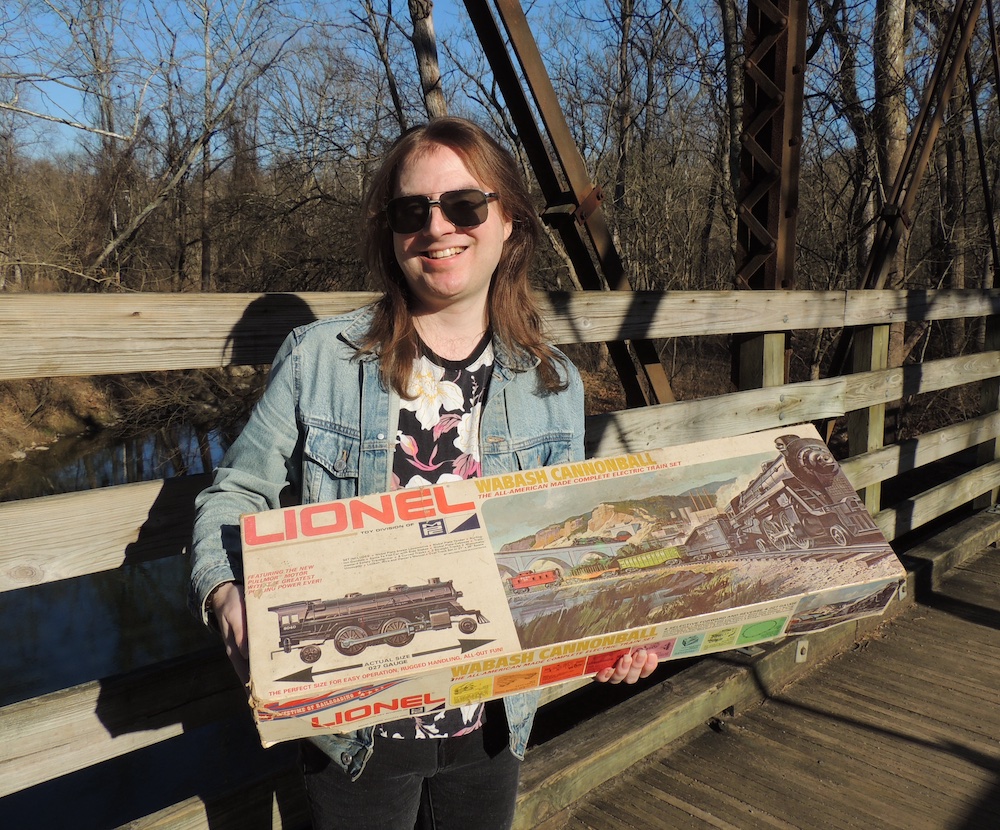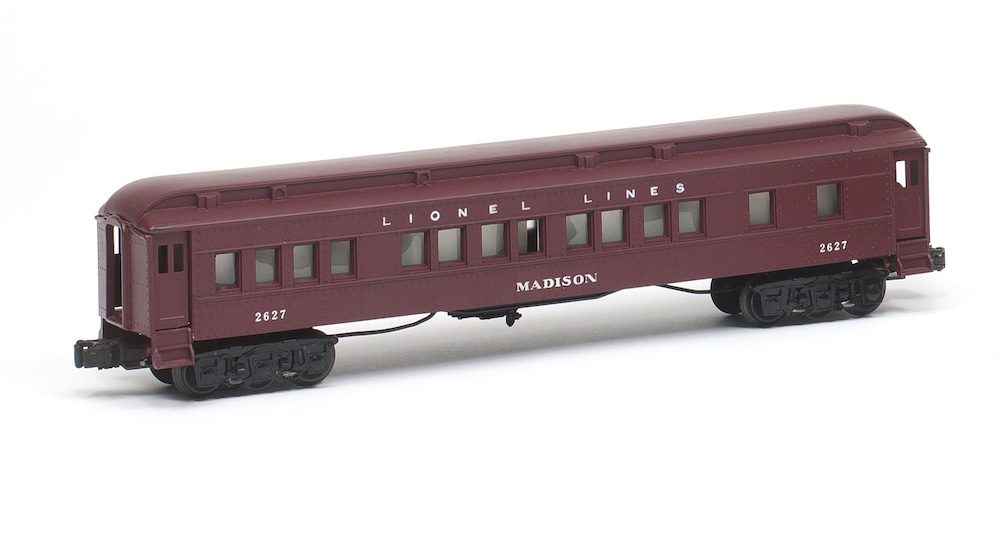Last year we visited Las Vegas’ hot garden railways, which were set against a vast arid moonscape, or so it seemed to this New Englander (now gardening in northern California). As I looked closer, I saw beautiful gems of silver-blue, coral, and sage-green set in a sea of khaki. Diverse in color and texture, all shared a common goal of conserving moisture. Some gardeners in this Great Basin Desert even provided a canopy of much needed shade trees, such as mesquite (Prosopis chilensis) or paloverde (Cercidium floridium) to conserve moisture! Thanks!

Why would we northerners want to model the desert? Because we can! It’s pretty easy, given the few rules listed below. This article is intended to aid railway gardeners who live in both hot and cold climates to model any desert.
Many deserts are located in parks that we can visit in person, online, or in books to get a feel for their characteristics. In western North America alone there are six desert “provinces:” Mohave, Sonoran, Chihuahua, Great Basin, Painted, and Colorado (actually in southern California). Each desert has its own prominent and unique features, as do those in Africa, Australia, and Asia.
Maine to Mohave
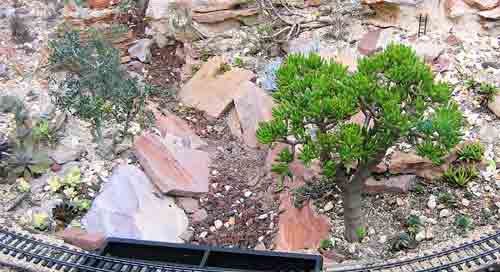
There’s even a desert in New England! That’s right. 11,000 years ago, glaciers deposited a desert-full of sand in Freeport, Maine. Visit www.desertofmaine.com to learn about its geological history. Like a huge golf-course sand trap, Maine’s “100% certified” desert is surrounded by a forest of pine, spruce, and fir, which would blend nicely into a northern rail line’s landscape.
If you’d prefer to model Maine’s Sandy River & Rangeley Lakes rather than the Santa Fe, you can legitimately tie in such a desert. It’s the perfect excuse for a practical footpath to access other areas of your railway. Instead of blow-away sand, use sifted, compactable decomposed granite in tan-to-pink tones. For easy maintenance, compact the sub layer with drainage material, then mix dry mortar into the sand. Create slightly peaked dunes, then gently mist. Experiment first, as building materials vary by area.
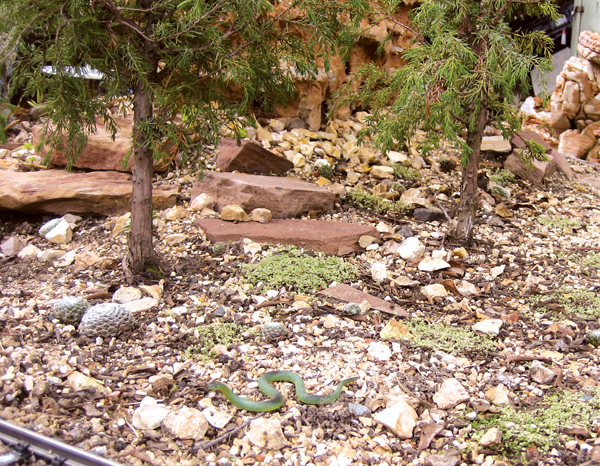
I prefer a “rainbow of pastels” for a showy desert scene sparkling in the sunniest part of the garden. Typical of the Sonoran and Colorado deserts, giant cacti, like Joshua tree (Yucca brevifolia) and saguaro (Carnegiea gigantea), can be modeled by succulents found at most garden centers. Some of these are intended for indoor growing in colder climates, so they will need to be protected or planted in clay pots and brought in during the winter. Outdoors, hide the pots with gravel.
Butte, mesa, dustbowl, flats
These unfamiliar terms define topography that is fascinating and desolate, mysterious yet measurable. As modelers, we need a framework, like a skeleton, to support our models. I use rocks as the backbone to create the structure. Unless you are fortunate to have rock outcroppings on your land, start by visiting several landscape-material yards, as their sources are often different. Ask if they have red, pink, lava, or exotic rock that looks painted. Even if all they have is gray, look for striations of color.
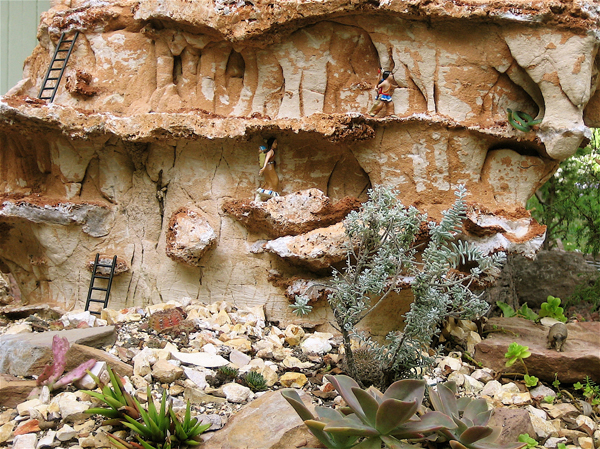
Three shapes of rock will create your skeletal structure: round, flat, and crushed. Half-buried boulders or flagstone against a fence give a mountain-in-the-distance feel. Tumbled flagstone has at least three uses: stacking, leaning for retaining walls, and partially buried (vertically) as a focal point. Crushed or lava rock makes a good mulch to prevent erosion and cover all soil. I use ginger fines for track ballast.
Because desert plants need excellent drainage, it’s imperative to add lots of coarse sand to your planting soil. The best way to ensure drainage is to raise your garden with rock, which will give the plateau/canyon look we associate with this area. Plateaus also serve as roadbed for track, and canyon floors for walking on. Several stand-alone rock formations can be built by stacking combinations of rock with an eye on your picture of the prototype. Now let’s flesh out the skeleton.
Succulents to sagebrush
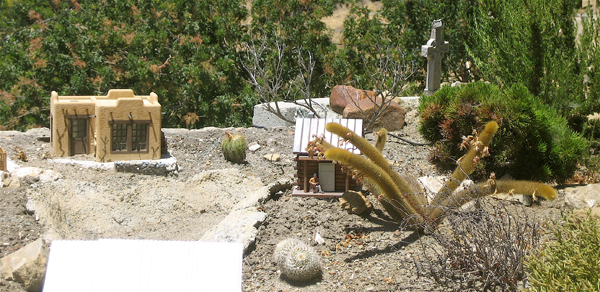
“Fleshy” is just the word to describe the efficient plant group called succulents. It’s all about water retention. Cacti belong to this group, with their stems (not leaves) being their canteen. Other xeriphytic (dry loving) plants can be modeled as chaparral-type plants, including sages, lavender, helichrysum, and many Australian and South African plants, newly introduced, with that silvery, waxy look. More and more, you’ll find drought-tolerant species in nurseries to save on irrigation.
To drape over cliffs, I like a frost-hardy Australian dwarf Grevillea ‘Woodburn Pink’ with winter-blooming pink flowers here in Zone 9. A similar look is grayish germander (Teucrium chamaedrys), frost-hardy to Zone 5. So look in your area for plants with a silver cast to act as a transition to your desert: Artemisia versicolor ‘Sea Foam’ is a finely textured, Zone 4 wormwood that lives just as well in Zone 9.
Don Parker, in his April 2005 “Miniscaping” column, “Succulents,” did an excellent job grouping succulents by genus or type and offering several examples. Then, in December 2007, Pat Hayward’s “Pathways” column, “Cacti and succulents in the garden railway,” showed us how those who live in Zone 10 find great plants to model the desert.
Many a succulent will winter over nicely in Zones 3 and 4 if their feet get good drainage. Northerners will find the chunky rosettes of hen-and-chicks (Sempervivum sp.) in a wide variety of colors and sizes, creating mock barrel cacti and Agave sp. Groundcover is covered with the stonecrops (Sedum sp.)
You can train twisted junipers, like Juniperus horizontalis ‘Bar Harbor’ (Zone 4-9), into mountainous, wind-blown specimens of the high desert: prune to maintain a Bonsai shape. Restrict their roots with rock slabs a few inches under the surface. By the way, Bar Harbor juniper grows atop a mountain on Mt. Desert Island in Maine, so named because it is treeless and almost without soil.
Mirage or oasis
I’ve been finding small sago palms (Cycas revoluta) in garden centers. Sagos are like the desert-considered living fossils and among the oldest species on earth. Why not let fossil rocks or petroglyphs tell the story of your oasis? Another small mock palm, Aeonium arboreum ‘Schwartzkopf’, wows us with almost-black leaves in stark contrast to sage-blues.
Watercourses rarely occur in deserts but maybe you’d like to model Painted Desert’s falls, plunging from sheer, red canyon cliffs in Zion National Park in Utah. Last year I visited a model of the Grand Canyon at The Living Desert’s garden railway in Palm Desert, California (www.livingdesert.org), so I can imagine rafts floating down a miniature ruddy-red Colorado River.
If you plan to mortar your riverbed liner, use color powders or liquid. If you can’t find the buff/red color, there’s a simple alternative. Mix a few ounces of ferrous sulfate (FeSO4) fertilizer in a quart spray bottle of water and squirt away while the mortar is curing. You’ll see green, but the mortar will dry to rust, appropriate for a southwest riverbed.
Details breathe in life or death, as the case may be
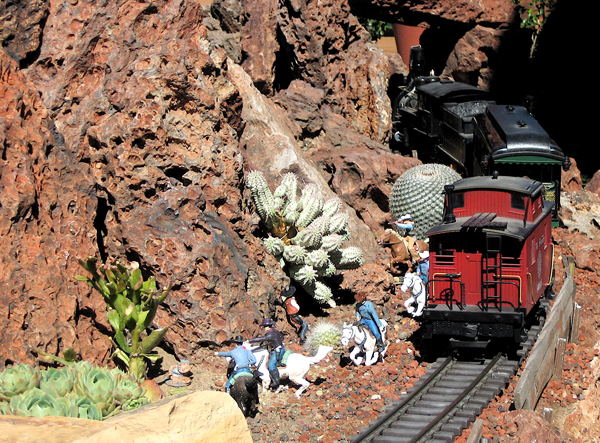
Our first garden railway, built for my young grandson, had to have a small patch of desert. I loved the soft hues and texture; my grandson liked multiplying them by picking off leaves and watching roots grow as they lay on the ground. Then there was the dark side of desert railroading.
The arrow-punctured stagecoach carried hats and baggage but pioneers and horses were mysteriously missing. The watering hole was a buried plastic tray obscured by muddy water, announced by a skull-and-crossbones sign on a Popsicle stick. Scattered cattle skulls warned skinny Playmobile ponies to go elsewhere but one of them lay stiffly on its side, no longer able to rise. In spite of prominent X’s where eyes used to be, the corpse rose from that spot every open house, when sympathetic giants hiked through. Only armadillos and anteaters dared the heat while buzzards waited patiently on dead tree limbs, or was it because they were wired to the tree?
Like a yard sale of costume jewelry, amethyst Echeveria rosettes, turquoise chalk sticks, pea-green string of pearls, and coral aloe flowers all spoke the desert language of “come and check us out!” Being in the front of the railway gave a vantage point that secured everyone’s attention, drew chuckles, and sometimes blood when someone had to touch that !%@&# cactus.
Reference
Cactus Country: An Illustrated Guide by John A. Murray, Roberts Rinehart Publishers, Boulder, Colorado, 1996








